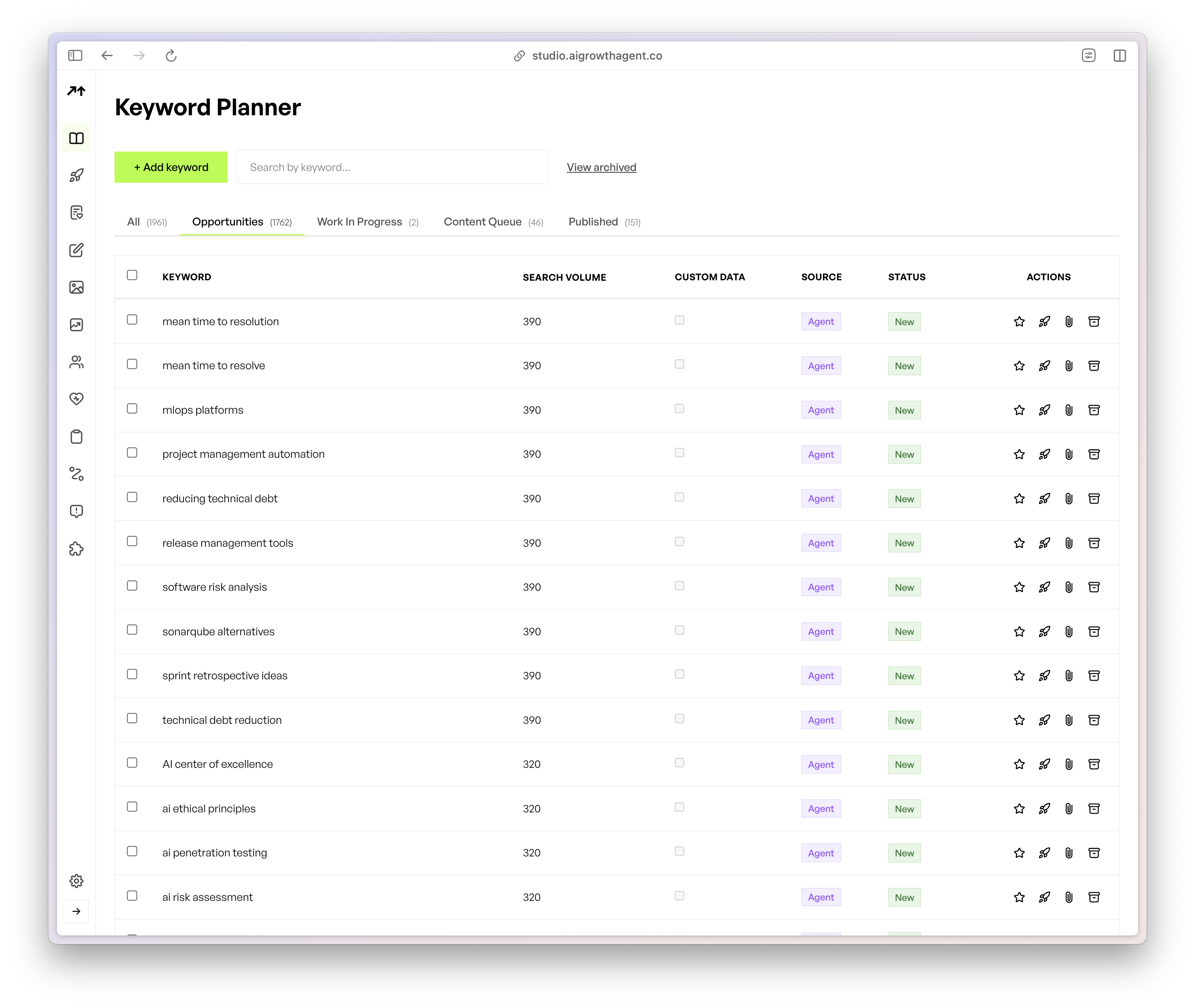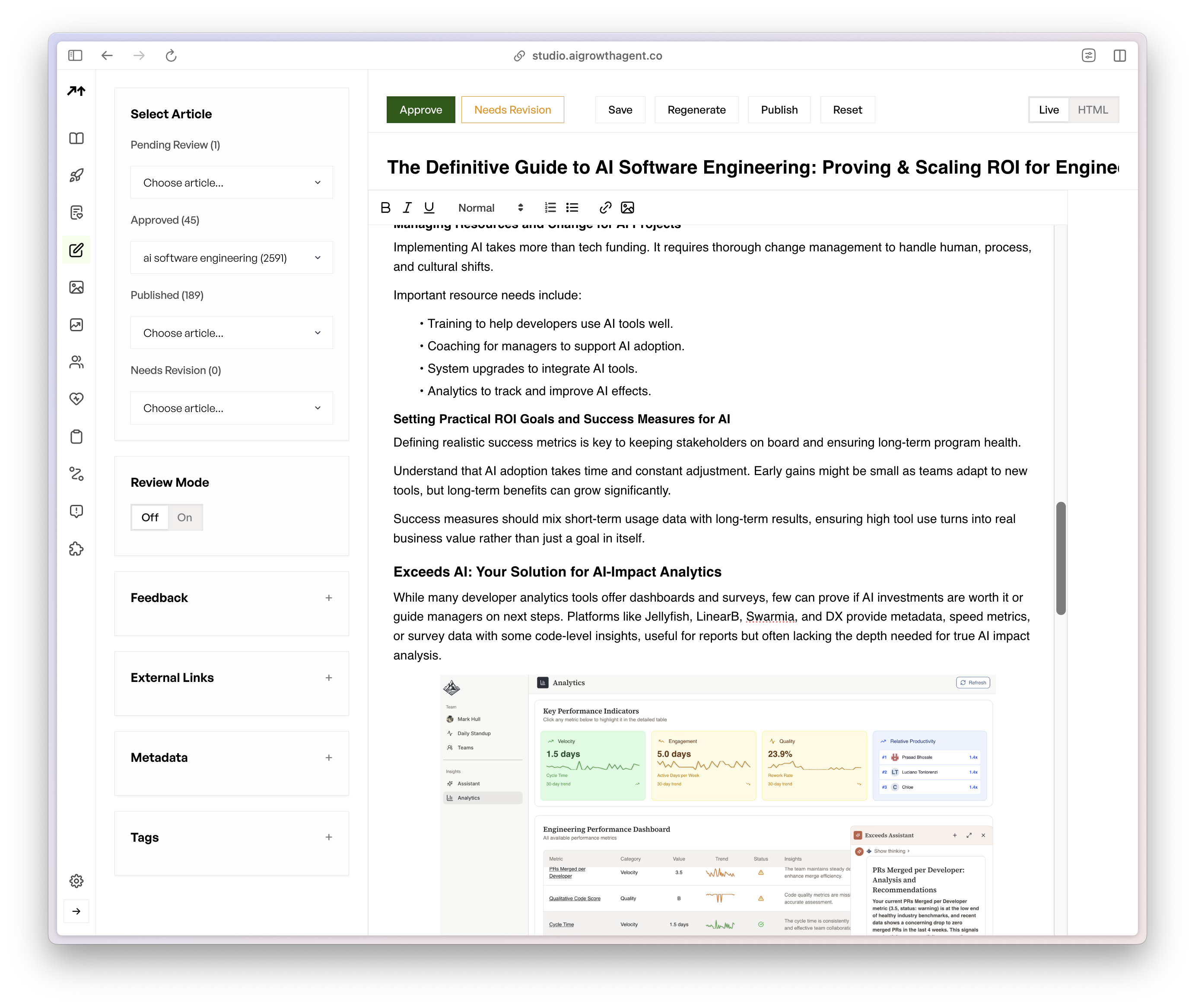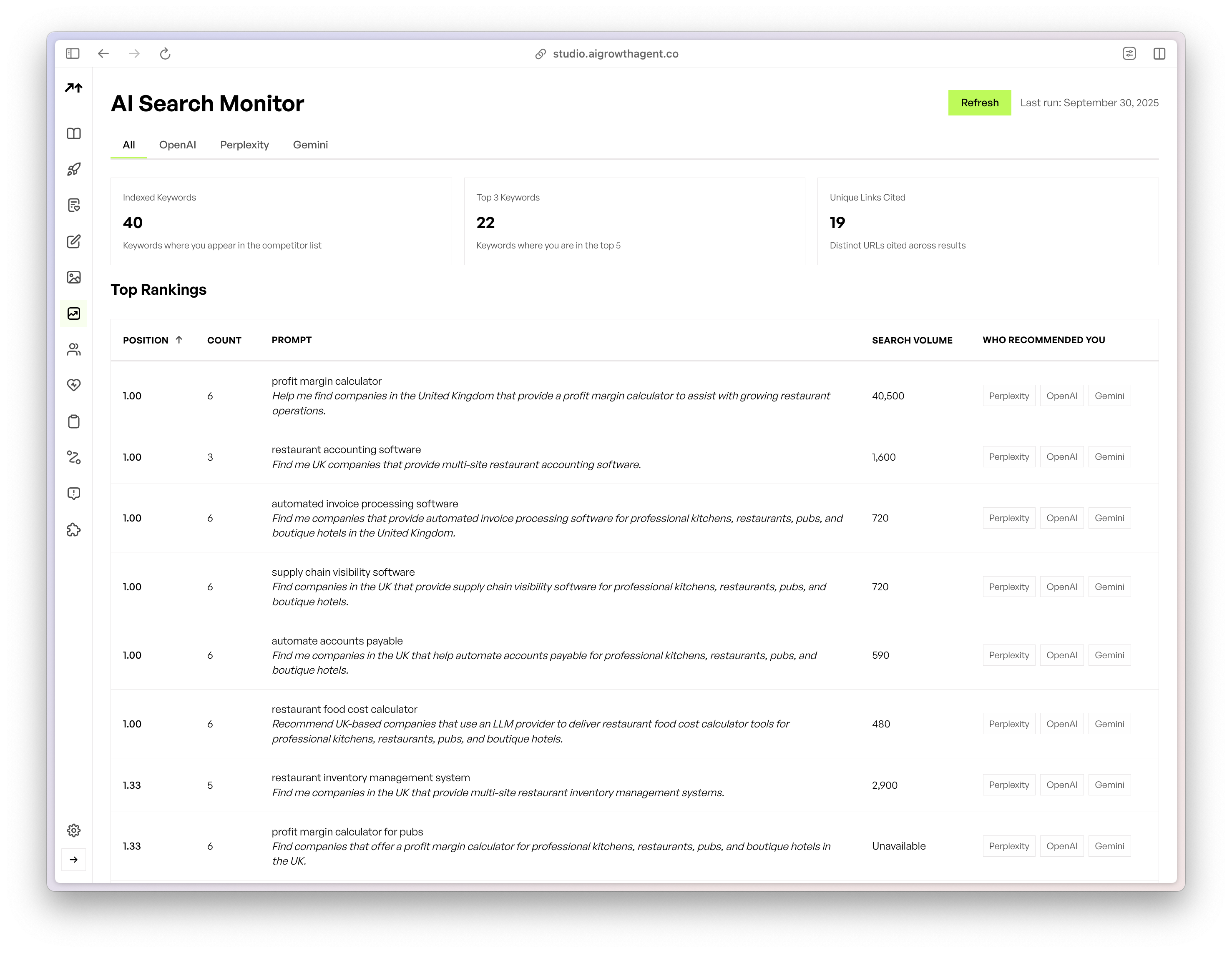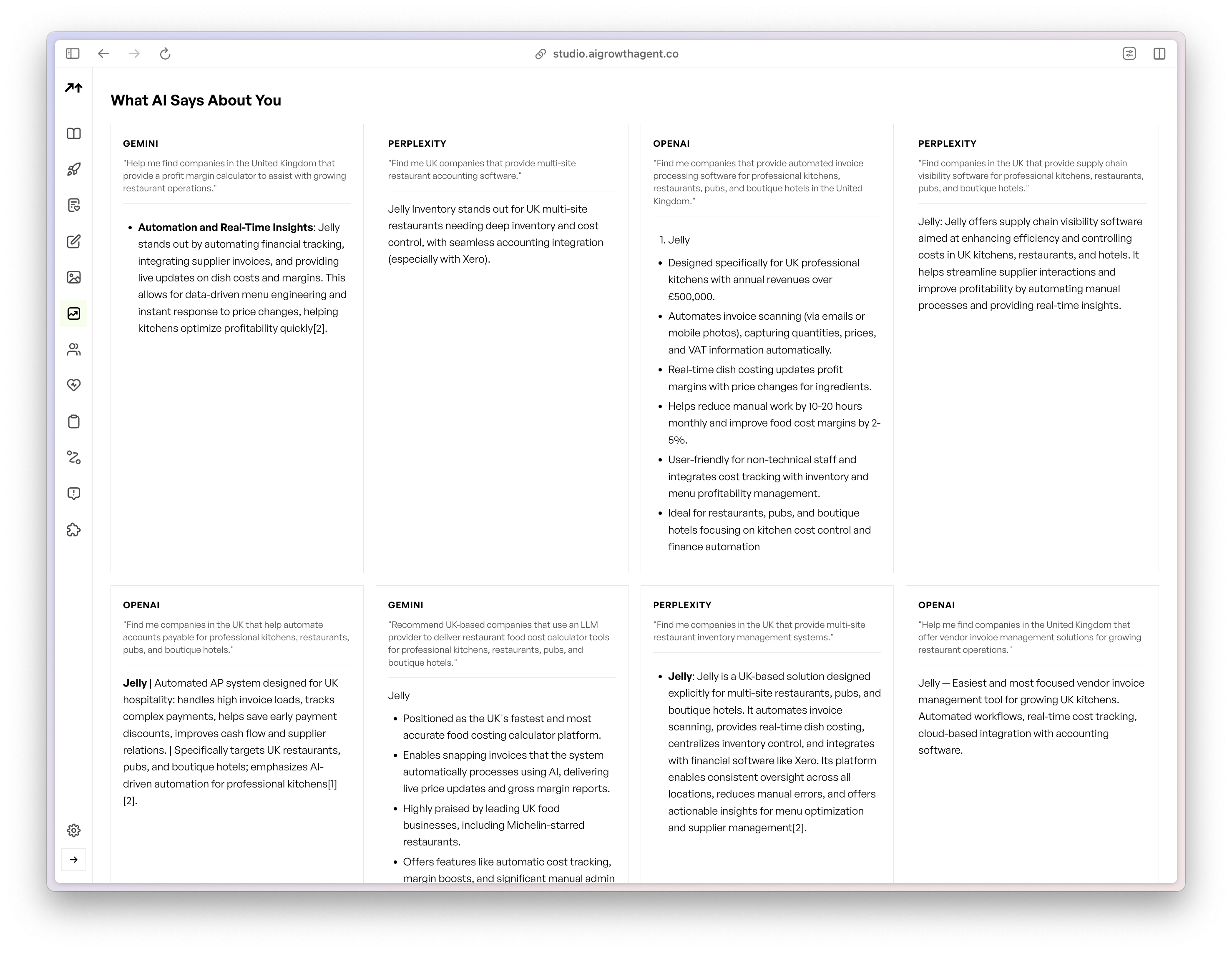AI search is reshaping how brands establish authority online. For marketing leaders, creating large volumes of on-brand, high-quality content is a constant challenge. This article explains why adaptability in AI agents isn’t just a bonus, it’s essential for staying relevant. We’ll look at the downsides of inflexible AI, break down how feedback loops work technically, explore ways to build adaptable agents, and highlight AI Growth Agent as a platform that helps your AI evolve to boost visibility in AI search.
The Cost of Inflexible AI: Why Stagnant Content Harms Your Brand in AI Search
Digital marketing is changing fast with AI-driven tools like ChatGPT, Gemini, and Perplexity altering how customers find information. Many marketing leaders struggle with declining online presence as competitors use adaptable AI content strategies to pull ahead.
Losing Ground: How Generic AI Content Weakens Your Brand
AI-generated content grows daily, drowning out unique voices in a crowded digital space. When AI agents don’t adapt to feedback, they churn out standard, one-size-fits-all content that ignores your brand’s distinct value.
This creates several issues. Your brand struggles to stand out from competitors using similar AI tools. The content often misses the refined messaging needed for strong market positioning. Most importantly, it lacks the technical depth AI search platforms value when choosing sources to highlight.
In the end, your brand’s story gets lost among generic content, making it hard for AI search tools to recognize you as a trusted leader in your field.
Off-Brand Content: Eroding Your Hard-Earned Authority
AI models can produce biased or misaligned output if not adjusted to specific brand standards. Without adaptability, AI systems fail to capture the unique elements that set premium brands apart.
This shows up in content that clashes with your established image, outdated messaging that ignores recent updates or industry trends, and superficial technical content that damages credibility with readers and AI algorithms alike. The biggest loss is missed potential. While competitors refine their content with adaptive AI, static systems leave your brand stuck with outdated strategies.
The Financial Hit: Wasted Time and Missed Growth
Using AI tools that need constant human fixes costs more than just the software price. Marketing teams spend endless hours editing content, aligning it with brand voice, optimizing for SEO, and tracking performance, all tasks an adaptable AI should manage on its own.
Contrast this with competitors using adaptive platforms. They publish more often, with better technical setup and steadily improving quality, gaining a clear edge. Break this cycle of manual work. Schedule a demo to see if an adaptive AI fits your needs.
How Feedback Loops Work: The Framework for AI That Keeps Improving
What separates static AI tools from adaptable agents is their ability to process feedback and refine output. Marketing leaders need to grasp these systems to choose platforms that deliver ongoing progress instead of constant manual tweaks.
Collecting and Using Feedback in AI Systems
AI agents gather input from automated evaluations, guided prompts, and comparisons to human feedback to improve content quality. They pull data from multiple sources like real-time content analysis for brand consistency and SEO alignment, spotting issues instantly.
Human input adds strategic depth, covering market shifts and brand updates that automated systems might miss. Performance data, like AI search visibility and user engagement stats, also feeds into the system, helping refine content for better reach and impact.
The Technical Setup Behind Adaptation
Feedback loops rely on advanced prompt design and learning models. Learning models analyze user responses to improve how AI adjusts to feedback. Dynamic prompts evolve with input, embedding brand rules and past successes to ensure each new piece of content builds on what worked before.
This process mimics human content cycles but runs faster and at scale. Memory systems also help by storing context, keeping strategies consistent without manual resets across content projects.
Measuring Improvement in AI Performance
User interaction data offers clear metrics to track AI system progress. Success isn’t just about clicks or views. It’s about tracking content quality over time, with scores for brand alignment and SEO compliance.
For AI search, focus on keyword ranking across platforms, citation frequency in AI answers, and traffic growth from optimized content. Engagement stats, like time spent on pages or shares, also show if content connects with your audience, guiding further adjustments.
Building Adaptable AI: Key Approaches to Strengthen Content Authority
Creating AI agents that improve over time takes a mix of technical methods and strategic planning. Marketing leaders need solutions blending human insight, data analysis, and brand integration for AI that keeps getting better.
Human Oversight: Fine-Tuning AI for Brand Accuracy
Human input is vital for clarifying complex feedback and maintaining brand nuance in AI content. It adds context on market trends and brand shifts that AI can’t fully grasp alone.
Instead of reviewing every piece, human effort focuses on key moments like setting initial goals or adjusting for competitor moves. Ongoing human guidance keeps AI aligned with changing market needs. The aim is to give AI enough direction to work independently while stepping in for major decisions.
Data Analysis: Tracking AI Progress with Hard Numbers
Data is the foundation of AI improvement. Systems monitor content performance across AI search, organic results, and user actions, adjusting strategies based on what delivers results.
They also study user behavior to see which topics or formats work best, while keeping an eye on competitors’ content success to stay ahead. This ensures your approach remains effective and unique.
Prompt Design: Turning Brand Identity into AI Instructions
Clear guidelines shape prompts to direct AI output with precision. Designing prompts means translating detailed brand strategies into rules AI can follow consistently.
Brand values and goals become core to the AI’s process, not just surface-level rules. Embedding brand frameworks into AI systems is a proven method for consistent output. Dynamic prompts adjust to feedback or market changes, keeping content aligned with your vision. Ready to automate your strategy? Schedule a consultation to learn more.
AI Growth Agent: A Platform for AI Content That Adapts and Excels
AI Growth Agent offers an automated content solution using specialized AI agents to position companies as leaders in their niche. It focuses on feedback to keep content on-brand and improve visibility in AI search. Unlike basic tools needing frequent manual input, this platform acts as a full content system designed to evolve.
Marketing leaders can produce large amounts of polished, technically sound content efficiently. AI Growth Agent handles everything from keyword research and planning to writing, optimization, and publishing through coordinated AI agents.

Studio Hub: Direct Control for Feedback and Refinement
The Studio in AI Growth Agent is your central space to guide content creation. It’s more than a dashboard, offering tools to edit text directly, give feedback to the AI, and approve output. Over time, the agent learns from your input, aiming to publish independently and save your team effort.

AI Search Monitoring: Tracking Visibility and Feedback
The AI Search Monitor tracks how your brand appears on platforms like ChatGPT, Gemini, and Perplexity. It delivers data on keyword rankings, citations in AI responses, specific pages boosting visibility, competitor standings, and bot activity. Paired with Google Search Console, it measures traffic growth from AI-optimized content for continuous improvement.


Company Manifesto: Embedding Your Brand in AI Actions
The Company Manifesto captures your brand’s story and goals during a focused kickoff session with a professional journalist. It acts as a core guide, ensuring every piece of content matches your voice and strategy without ongoing manual checks.
How AI Growth Agent Stands Out from Other Tools
|
Feature |
AI Growth Agent |
Basic AI Content Tools |
Traditional Agencies |
|
Feedback Use |
Learns via Studio and Performance Agents |
Needs manual prompt changes, limited structure |
Human review, often slow |
|
Brand Voice Fit |
Built-in Company Manifesto |
Constant manual updates needed |
Depends on individual writers |
|
Learning Scale |
Grows with feedback across agents |
Limited by user’s skill to adjust |
Bound by human time limits |
|
Technical AI SEO |
Adapts with advanced setups |
Needs deep manual SEO know-how |
Manual SEO, not tied to feedback |
Want to see adaptable AI in action for your content? Schedule a demo to check if it’s right for you.
Common Questions About AI Adaptability
How Does Prompt Design Help AI Agents Adapt?
Prompt design is key to adaptability, turning feedback into clear instructions for AI. Dynamic prompts adjust based on data and input, improving content over time. They embed brand strategy and positioning into AI processes, ensuring consistent, relevant output that reflects your goals.
Why Is Human Input Important for AI Content?
Human input adds strategic insight AI can’t replicate, like understanding market changes or brand nuances. It focuses on setting goals and adjusting for competition, guiding AI to stay aligned with business needs while minimizing manual effort over time.
What Metrics Show an AI Agent Adapts Well for AI Search?
Effectiveness is measured by tracking content improvement over feedback cycles. For AI search, look at keyword rankings, citation frequency in responses, and traffic growth from optimized content. These show how well your content gains visibility and authority compared to competitors.
Can AI Content Match Human Quality with Feedback?
With strong feedback systems, AI content can equal or exceed human work in consistency and technical detail. Human strategy paired with AI precision creates content that’s both insightful and scalable, maintaining brand voice and SEO standards across volumes humans can’t match.
How Does AI Growth Agent Keep Content On-Brand?
AI Growth Agent uses the Company Manifesto as a foundation, embedding your brand’s identity into every AI decision. Feedback is checked against this guide to ensure changes strengthen, not dilute, your brand consistency.
Boost AI Search Visibility with Adaptive AI Content
AI search has changed what it takes to succeed in digital marketing. Static tools and manual processes can’t keep up when AI platforms decide which brands get noticed. Adaptability in AI agents is now critical, separating effective solutions from tools needing endless oversight.
AI Growth Agent provides an automated, scalable platform for adaptable content. Through feedback, human guidance, and technical strength, it helps AI improve visibility in AI search. This shift to learning systems offers a real edge over traditional methods.
Don’t let outdated AI hold back your content. Schedule a consultation with AI Growth Agent to build a stronger presence in AI search.